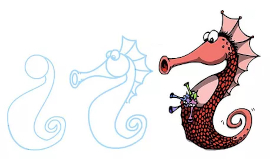I’ve been a fan of Mark Kistler’s for many years, and now students have access to his inspiration and teaching skills in an even better format through online lessons at Mark Kistler's Draw 3D. A one-year subscription provides access to hundreds of video lessons that can be used by the entire family working together or individually. There are also group membership prices that might be of interest to some homeschool groups.
The website features four levels of lessons, all accessible with your subscription: Mini-Marshmallow (for ages four and up), Beginner, Intermediate, and Advanced. The starting age for all but the Mini-Marshmallow lessons is seven. In addition to the four levels, there are many more lessons under tabs for the 30-Day Drawing Challenge!, Hour of Pencil Power, and 199 Days of Drawing.
Free sample lessons for each level let you try before buying, and there is also a set of nine free lessons under NASA's #DrawARTemis—all related to space exploration.
Kistler makes the lessons fun with his kid-friendly teaching style. He often creates stories while he’s drawing. For example, while drawing a birthday cake, he creates a story about ants coming to attack the cake and eating a door into the side—illustrating each development as he narrates.
In the Mini-Marshmallow lessons, Kistler teaches how to draw a specific element in each lesson. Rather than teaching isolated skills, he uses the context of the simple drawings. For example, students can start by drawing an “alien blob.” In the process, they learn about drawing items smaller or larger to make them appear further away or closer. Another lesson teaches how to draw a group of daisy-like flowers in which children learn how to create texture to simulate the ground. They also learn how to use horizon lines and shadowing. Most students will not be able to draw as quickly as Kistler, so they will need to stop and start the videos as they work through the drawings themselves.
Kistler's lessons gradually become more challenging. Advanced lessons are much more complex than Beginner lessons since they generally include several items in each drawing and teach advanced techniques. By this level, students are creating amazing, three-dimensional drawings. Students learn realistic drawing techniques, although the subjects in these lessons are generally cartoonish or imaginative. With Kistler’s guidance, it’s gratifying to see how quickly students can achieve an outstanding level of skill.
Students should work in a sketchbook to keep their drawings together. All work is done simply with pencil and paper—no fancy or expensive resources required.
Several printable resources are available even without subscribing. Among these are “12 Renaissance Words” which illustrates and explains 12 basic drawing techniques such as foreshortening, overlapping, and contour on a single page. Likewise, you will probably want to print out the “Drawing Compass” that helps students think about the orientation of elements in their drawings. These are great references to remind students of basic techniques and also those that make drawing both fun to do and interesting to look at. Subscribers will probably appreciate the downloadable Progress Charts for keeping track of lessons students have completed in the various courses.
While it would be great for two or more students to watch the lessons and work through them together, the lessons are equally good for those working independently. Instruction is thorough so there’s no need for parent or teacher involvement other than to encourage students and compliment them on their efforts.








